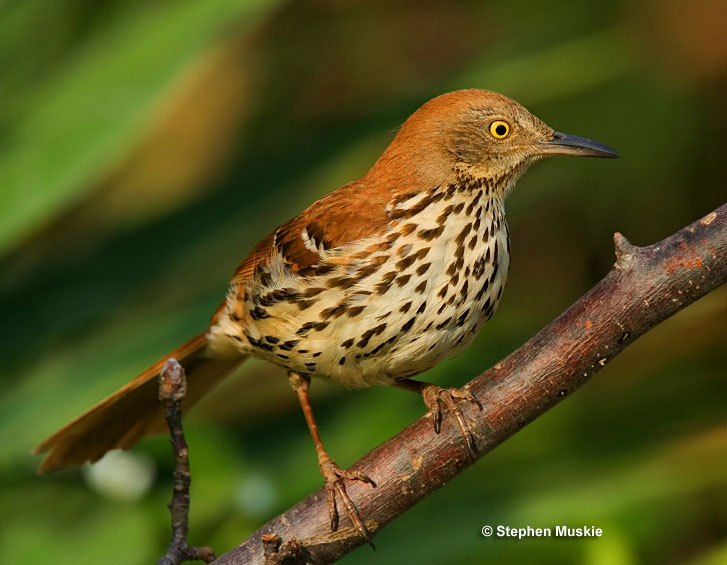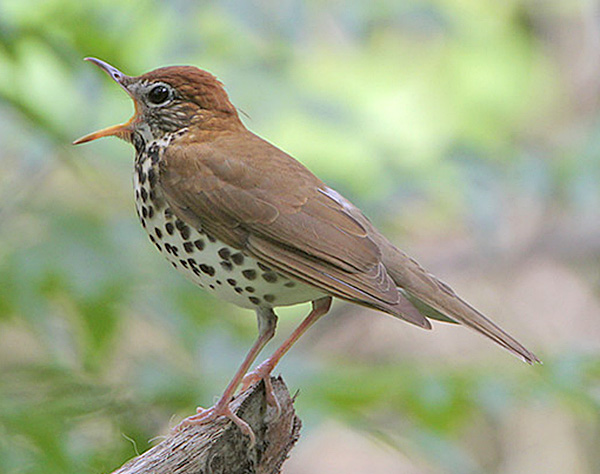Brown Thrasher, with its distinctive curved beak and beautiful rusty and whitish plumage, is a common sight in gardens and wooded areas throughout the eastern and central United States.
These birds are known for their wide song repertoire and somewhat aggressive behavior.
In this article, we will delve deeper into the fascinating world of Brown Thrashers, showing how to identify them, where to find them, and more.
Identification
Brown Thrashers are a beautiful bird species, with both male and female birds looking the same. They have warm rusty-brown plumage on their upper side, black-and-white wingbars, and their underside is whitish with vertical dark streaks, which gives them a distinctive appearance.
Their pale, long, and slender legs and long, slightly curved black bill are also noticeable features. You might notice their brilliant yellow eyes, which are striking against their brown and whitish plumage. You can often observe it keeping its long tail cocked upwards.
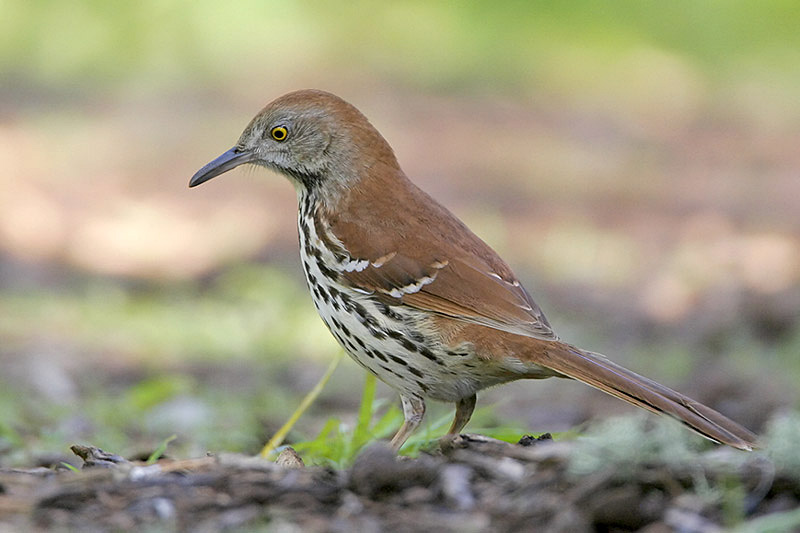
Photograph © Greg Lavaty.
Brown Thrasher’s size is somewhere between that of a Northern Mockingbird and a Blue Jay, which makes it relatively large among other thrashers. They grow 9.3-12 inches long and have a wingspan of 11-13 inches.
These birds are known to have over 1100 types of songs and for mimicing their surrounding noises. Brown Thrasher’s songs include phrases such as bury it-bury it, eat it-eat it, plant a seed-plant a seed, cover it up-cover it up, and much more.
Only males sing, repeating one phrase two times before moving on. There is no definite beginning or end to the song, and they can sing for many minutes. They can also mimic other birds, so don’t be surprised when a Brown Thrasher sounds crudely similar to a Wood Thrush, Northern Cardinal, or another bird species.
Brown Thrasher’s calls consist of one or a few repeated notes and they have various purposes. Both females and males make smack and teeooo alarm calls and a hijjj sound at dusk and dawn. Other calls include whistles, chirrups, harsh slurs, and chatters.
Food
The Brown Thrasher is an omnivorous bird. The animal part of their diet includes mostly insects, but also beetles, caterpillars, grasshoppers, spiders, earthworms, snails, and bees with the occasional small lizard, reptile, or frog.
The plant-based part of their diet includes fruits, berries, seeds, and nuts, such as blueberries, elderberries, raspberries, currants, cherries, and acorns.
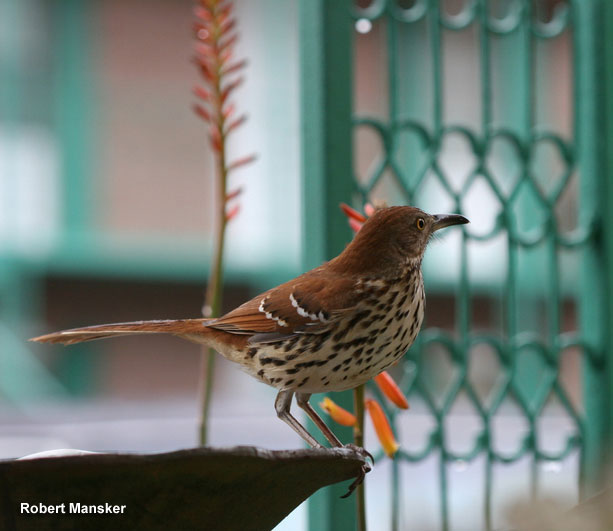
During the breeding season, the diet consists mainly of animal matter, such as beetles, grasshoppers, and other arthropods, with the remaining part being fruits, nuts, and seeds. As summer turns to fall, the diet shifts to a more herbivorous one, focusing on fruits, nuts, seeds, and grains. Wintering birds mainly eat fruit and acorns.
Brown Thrashers forage for food on the ground using its bill to sweep the soil and leaf litter, with quick side-to-side movements. They can also perch in shrubs or trees to eat berries.
Sometimes you may see them extend their necks to snatch insects quickly. The bird may hammer nuts and acorns with its bill to get to the tasty core.
Nesting and Eggs
This species is typically monogamous. The male establishes a territory by singing loudly and starts calling out with a tick or tchuck. Typically, the male approaches the female and offers small gifts, such as leaves or sticks. After the bond is formed, the pair starts building the nest.
You can see Brown Thrashers nesting in dense shrubs, low trees, or vine tangles 2-7 feet above the ground. On rare occasions, you may find their nest right on the ground.
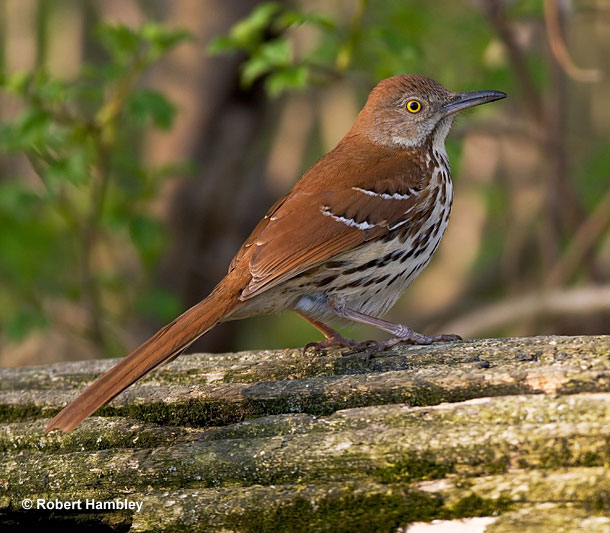
A Brown Thrasher’s nest is a bulky structure. The pair build a foundation of sticks that support the loose cup made of twigs, leaves, weeds, and thin bark. The cup is lined with finer and softer materials. They will mate only after the nest has been built.
This species can have 1-2 broods in a year with 2-6 eggs in a clutch. Brown Thrasher’s eggs are about an inch long and a little under an inch wide. These glossy pale blue to green or white eggs with many red-brown speckles take around 10-14 days to incubate and it is done by both parents.
Young leave the nest about 9-13 days after hatching and become independent at 17-19 days.
Juvenile Brown Thrashers are not that different from adults. They can only be distinguished by a slightly different plumage texture, blurrier vertical streaks on the underside, and their olive-colored eyes.
Current Situation
Brown Thrashers range in eastern and central United States and southern and central Canada. They’re permanent residents in the south but mostly migratory in the north. Some may remain in the north and feed in thickets with many berries or at birdfeeders.
Brown Thrashers live in various warm and dry habitats that offer dense cover, such as woodland edges, thickets, dense brush, and thorn scrubs but also suburban and agricultural areas. They spend most of their time foraging near the ground. Brown Thrashers are known to compete with other species for nesting spots and food sources.
Unfortunately, they have a lot of predators but they’ve developed a few defense mechanisms to defend themselves and their nest.
Adults are aggressive and hit the predators with their bills to chase them away, causing significant damage to small and medium-sized predators. They also flap their wings and sing to ward off intruders.
Brown Thrashers are listed as of least concern in the IUCN Red List and are common and widespread in their range.
However, in addition to predation, they’re threatened by pesticides, degradation of habitats, and flying into structures. Luckily, it has yet to cause significant harm to the size of its population although if this continues, it may eventually become a problem.
Facts
- Brown Thrashers are aggressive when it comes to defending their nest and young. They will sing, flap their wings and ultimately attack predators and intruders, including humans, to chase them away. For such a small bird they can cause quite a bit of damage, drawing blood even from humans.
- Brown Thrasher is a bird of many names. They have been erroneously called the Brown Thrush or Fox-colored Thrush. It also has synonyms for its scientific name: Turdus rufus, Orpheus rufus, and Harporhynchus rufus.
- It is believed that Brown Thrasher’s name comes from its brown plumage and the thrashing sound it makes when sifting through the leaves and debris on the ground.
- Brown Thrasher is the state bird of Georgia.
- If you want to attract Brown Thrashers to your yard, you should plant berry-producing shrubs or place bird feeders near or on the ground. They offer food and the shrubs offer protection as well.
Similar Species
There are two species very similar to Brown Thrashers and these are the Long-billed Thrasher and Wood Thrush. The differences are quite minimal, so read further to discover how exactly they differ.
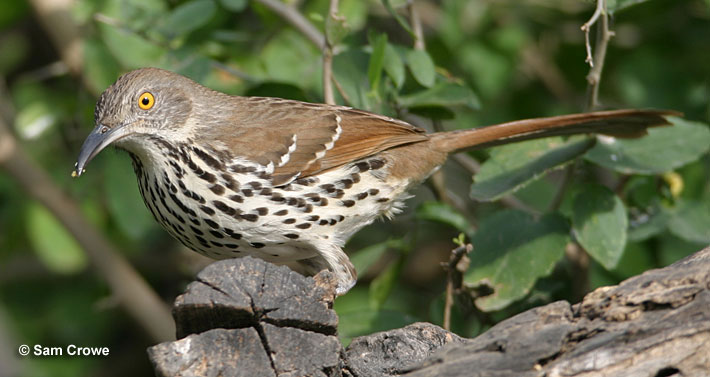
Long-billed Thrasher
Long-billed Thrashers – look almost identical to Brown Thrashers, but their plumage is darker and “colder”.
The brown on the upper side of their body is darker, the face is dark grayish, and the streaks are black as opposed to the warmer colors and dark brown streaks of the Brown Thrasher.
Luckily, their range only overlaps in south Texas and eastern Mexico.
Wood Thrushes – have similar coloring but are smaller and rounder.
They also have smaller and lighter bills and shorter tails.
Instead of streaks, they have dark spots on the underside of their body and their wings don’t have black and white bars.
Their eyes are black, whereas Brown Thrashers are known for their yellow eyes.
FAQ
Are Brown Thrashers rare?
Brown Thrashers are quite common within their range, although some decline in numbers has been noted in certain regions.
What are Brown Thrashers known for?
Brown Thrashers are known for having over 1100 types of songs and being very aggressive when protecting their nests, attacking anything, including humans, and possibly even drawing blood.
Where do Brown Thrashers live?
Brown Thrashers live in warm and dry habitats across the eastern and central United States and southern and central Canada. You can find them in thickets, brush, woodland edges, and thorn scrubs but even in suburban areas that offer enough hedges, shrubs, and dense brush.
What sounds do Brown Thrashers make?
Brown thrashers can have over 1100 types of songs that consist of various phrases repeated 2 times before switching to another. Their calls also consist of one or a few repeated notes, which can be made up of slurs, whistles, chirrups, or hissing sounds. They can also crudely mimic other birds.

